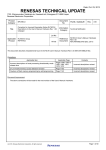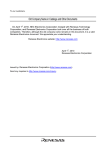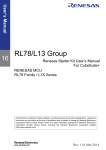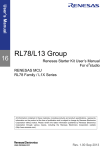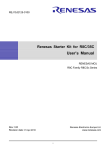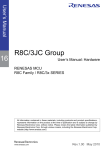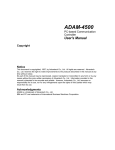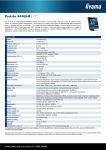Download Renesas Starter Kit for R8C/L3AC User`s Manual
Transcript
To our customers, Old Company Name in Catalogs and Other Documents On April 1st, 2010, NEC Electronics Corporation merged with Renesas Technology Corporation, and Renesas Electronics Corporation took over all the business of both companies. Therefore, although the old company name remains in this document, it is a valid Renesas Electronics document. We appreciate your understanding. Renesas Electronics website: http://www.renesas.com April 1st, 2010 Renesas Electronics Corporation Issued by: Renesas Electronics Corporation (http://www.renesas.com) Send any inquiries to http://www.renesas.com/inquiry. Notice 1. 2. 3. 4. 5. 6. 7. All information included in this document is current as of the date this document is issued. Such information, however, is subject to change without any prior notice. Before purchasing or using any Renesas Electronics products listed herein, please confirm the latest product information with a Renesas Electronics sales office. Also, please pay regular and careful attention to additional and different information to be disclosed by Renesas Electronics such as that disclosed through our website. Renesas Electronics does not assume any liability for infringement of patents, copyrights, or other intellectual property rights of third parties by or arising from the use of Renesas Electronics products or technical information described in this document. No license, express, implied or otherwise, is granted hereby under any patents, copyrights or other intellectual property rights of Renesas Electronics or others. You should not alter, modify, copy, or otherwise misappropriate any Renesas Electronics product, whether in whole or in part. Descriptions of circuits, software and other related information in this document are provided only to illustrate the operation of semiconductor products and application examples. You are fully responsible for the incorporation of these circuits, software, and information in the design of your equipment. Renesas Electronics assumes no responsibility for any losses incurred by you or third parties arising from the use of these circuits, software, or information. When exporting the products or technology described in this document, you should comply with the applicable export control laws and regulations and follow the procedures required by such laws and regulations. You should not use Renesas Electronics products or the technology described in this document for any purpose relating to military applications or use by the military, including but not limited to the development of weapons of mass destruction. Renesas Electronics products and technology may not be used for or incorporated into any products or systems whose manufacture, use, or sale is prohibited under any applicable domestic or foreign laws or regulations. Renesas Electronics has used reasonable care in preparing the information included in this document, but Renesas Electronics does not warrant that such information is error free. Renesas Electronics assumes no liability whatsoever for any damages incurred by you resulting from errors in or omissions from the information included herein. Renesas Electronics products are classified according to the following three quality grades: “Standard”, “High Quality”, and “Specific”. The recommended applications for each Renesas Electronics product depends on the product’s quality grade, as indicated below. You must check the quality grade of each Renesas Electronics product before using it in a particular application. You may not use any Renesas Electronics product for any application categorized as “Specific” without the prior written consent of Renesas Electronics. Further, you may not use any Renesas Electronics product for any application for which it is not intended without the prior written consent of Renesas Electronics. Renesas Electronics shall not be in any way liable for any damages or losses incurred by you or third parties arising from the use of any Renesas Electronics product for an application categorized as “Specific” or for which the product is not intended where you have failed to obtain the prior written consent of Renesas Electronics. The quality grade of each Renesas Electronics product is “Standard” unless otherwise expressly specified in a Renesas Electronics data sheets or data books, etc. “Standard”: 8. 9. 10. 11. 12. Computers; office equipment; communications equipment; test and measurement equipment; audio and visual equipment; home electronic appliances; machine tools; personal electronic equipment; and industrial robots. “High Quality”: Transportation equipment (automobiles, trains, ships, etc.); traffic control systems; anti-disaster systems; anticrime systems; safety equipment; and medical equipment not specifically designed for life support. “Specific”: Aircraft; aerospace equipment; submersible repeaters; nuclear reactor control systems; medical equipment or systems for life support (e.g. artificial life support devices or systems), surgical implantations, or healthcare intervention (e.g. excision, etc.), and any other applications or purposes that pose a direct threat to human life. You should use the Renesas Electronics products described in this document within the range specified by Renesas Electronics, especially with respect to the maximum rating, operating supply voltage range, movement power voltage range, heat radiation characteristics, installation and other product characteristics. Renesas Electronics shall have no liability for malfunctions or damages arising out of the use of Renesas Electronics products beyond such specified ranges. Although Renesas Electronics endeavors to improve the quality and reliability of its products, semiconductor products have specific characteristics such as the occurrence of failure at a certain rate and malfunctions under certain use conditions. Further, Renesas Electronics products are not subject to radiation resistance design. Please be sure to implement safety measures to guard them against the possibility of physical injury, and injury or damage caused by fire in the event of the failure of a Renesas Electronics product, such as safety design for hardware and software including but not limited to redundancy, fire control and malfunction prevention, appropriate treatment for aging degradation or any other appropriate measures. Because the evaluation of microcomputer software alone is very difficult, please evaluate the safety of the final products or system manufactured by you. Please contact a Renesas Electronics sales office for details as to environmental matters such as the environmental compatibility of each Renesas Electronics product. Please use Renesas Electronics products in compliance with all applicable laws and regulations that regulate the inclusion or use of controlled substances, including without limitation, the EU RoHS Directive. Renesas Electronics assumes no liability for damages or losses occurring as a result of your noncompliance with applicable laws and regulations. This document may not be reproduced or duplicated, in any form, in whole or in part, without prior written consent of Renesas Electronics. Please contact a Renesas Electronics sales office if you have any questions regarding the information contained in this document or Renesas Electronics products, or if you have any other inquiries. (Note 1) “Renesas Electronics” as used in this document means Renesas Electronics Corporation and also includes its majorityowned subsidiaries. (Note 2) “Renesas Electronics product(s)” means any product developed or manufactured by or for Renesas Electronics. Renesas Starter Kit for R8C/L3AC User's Manual Renesas Single-Chip Microcomputer R8C Family Rev.1.00 2010.02 Disclaimer By using this Renesas Starter Kit (RSK), the user accepts the following terms. The RSK is not guaranteed to be error free, and the entire risk as to the results and performance of the RSK is assumed by the User. The RSK is provided by Renesas on an “as is” basis without warranty of any kind whether express or implied, including but not limited to the implied warranties of satisfactory quality, fitness for a particular purpose, title and non-infringement of intellectual property rights with regard to the RSK. Renesas expressly disclaims all such warranties. Renesas or its affiliates shall in no event be liable for any loss of profit, loss of data, loss of contract, loss of business, damage to reputation or goodwill, any economic loss, any reprogramming or recall costs (whether the foregoing losses are direct or indirect) nor shall Renesas or its affiliates be liable for any other direct or indirect special, incidental or consequential damages arising out of or in relation to the use of this RSK, even if Renesas or its affiliates have been advised of the possibility of such damages. Precautions This Renesas Starter Kit is only intended for use in a laboratory environment under ambient temperature and humidity conditions. A safe separation distance should be used between this and any sensitive equipment. Its use outside the laboratory, classroom, study area or similar such area invalidates conformity with the protection requirements of the Electromagnetic Compatibility Directive and could lead to prosecution. The product generates, uses, and can radiate radio frequency energy and may cause harmful interference to radio communications. However, there is no guarantee that interference will not occur in a particular installation. If this equipment causes harmful interference to radio or television reception, which can be determined by turning the equipment off or on, you are encouraged to try to correct the interference by one or more of the following measures; • ensure attached cables do not lie across the equipment • reorient the receiving antenna • increase the distance between the equipment and the receiver • connect the equipment into an outlet on a circuit different from that which the receiver is connected • power down the equipment when not is use • consult the dealer or an experienced radio/TV technician for help NOTE: It is recommended that wherever possible shielded interface cables are used. The product is potentially susceptible to certain EMC phenomena. To mitigate against them, it is recommended that the following measures be undertaken; • The user is advised that mobile phones should not be used within 10m of the product when in use. • The user is advised to take ESD precautions when handling the equipment. The Renesas Starter Kit does not represent an ideal reference design for an end product and does not fulfil the regulatory standards for an end product. ii Table of Contents Chapter 1. Preface .................................................................................................................................................. 1 Chapter 2. Purpose ................................................................................................................................................. 2 Chapter 3. Power Supply ........................................................................................................................................ 3 3.1. Requirements ............................................................................................................................................... 3 3.2. Power–up Behaviour .................................................................................................................................... 3 Chapter 4. Board Layout ......................................................................................................................................... 4 4.1. Component Layout ....................................................................................................................................... 4 4.2. Board Dimensions ........................................................................................................................................ 5 Chapter 5. Block Diagram ....................................................................................................................................... 6 Chapter 6. User Circuitry......................................................................................................................................... 7 6.1. Switches ....................................................................................................................................................... 7 6.2. LEDs ............................................................................................................................................................. 7 6.3. Potentiometer ............................................................................................................................................... 7 6.4. Serial port ..................................................................................................................................................... 8 6.5. Debug LCD Module ...................................................................................................................................... 8 6.6. LIN ................................................................................................................................................................ 9 6.7. Option Links................................................................................................................................................ 10 6.8. Oscillator Sources ...................................................................................................................................... 20 6.9. Reset Circuit ............................................................................................................................................... 20 Chapter 7. Modes.................................................................................................................................................. 21 7.1. Boot modes ................................................................................................................................................ 21 7.2. Single chip mode ........................................................................................................................................ 22 Chapter 8. Programming Methods ........................................................................................................................ 23 Chapter 9. Headers ............................................................................................................................................... 24 9.1. Microcontroller Ring Headers ..................................................................................................................... 24 9.2. Application Headers ................................................................................................................................... 26 Chapter 10. Code Development ........................................................................................................................... 30 10.1. Overview................................................................................................................................................... 30 10.2. Compiler Restrictions ............................................................................................................................... 30 10.3. Breakpoint Support ................................................................................................................................... 30 10.4. Memory Map............................................................................................................................................. 31 Chapter 11. Component Placement ...................................................................................................................... 32 Chapter 12. Additional Information........................................................................................................................ 33 iii Chapter 1. Preface Cautions This document may be, wholly or partially, subject to change without notice. All rights reserved. Duplication of this document, either in whole or part is prohibited without the written permission of Renesas Technology Europe Limited. Trademarks All brand or product names used in this manual are trademarks or registered trademarks of their respective companies or organisations. Copyright © 2010 Renesas Technology Europe Ltd. All rights reserved. © 2010 Renesas Technology Corporation. All rights reserved. © 2010 Renesas Solutions Corporation. All rights reserved. Website: www.renesas.com Glossary ADC Analog to Digital Converter CD Compact Disc CPU Central Processing Unit DAC Digital to Analog Converter E8a E8a on-chip debugger module EMC Electromagnetic compatibility ESD Electrostatic Discharge HEW High-Performance Embedded Workshop I/O Input / Output LCD Liquid Crystal Display LED Light Emitting Diode LIN Local Interconnect Network MCU Microcontroller Unit PC Personal Computer RAM Random Access Memory ROM Read-Only Memory RSK Renesas Starter Kit UART Universal Asynchronous Receiver Transmitter USB Universal Serial Bus 1 Chapter 2. Purpose This RSK is an evaluation tool for Renesas microcontrollers. This manual describes the technical details of the RSK hardware. The Quick Start Guide and Tutorial Manual provide details of the software installation and debugging environment. Features include: • Renesas Microcontroller Programming. • User Code Debugging. • User Circuitry such as switches, LEDs and potentiometer. • Sample Application. • Sample peripheral device initialisation code. The RSK board contains all the circuitry required for microcontroller operation. Note: * The option links for the user LEDs are not fitted by default. To use LEDs fit R76, R78, R80, R82 and disconnect Renesas LCD Panel from JA4. ** The option link for DLCDE pin is not fitted by default. To use Debug LCD fit R92 and disconnect Renesas LCD Panel from JA4. 2 Chapter 3. Power Supply 3.1. Requirements This RSK board operates from a 5V DC power supply. A diode provides reverse polarity protection only if a current limiting power supply is used. This RSK board is supplied with an E8a debugger. This product is able to power the RSK board with up to 300mA. When the RSK is connected to another system then that system should supply power to the RSK. All RSK boards have an optional centre positive supply connector using a 2.0mm barrel power jack. Warning The RSK board is neither under nor over voltage protected. Use a centre positive supply for this board. 3.2. Power–up Behaviour When the RSK is purchased, the RSK board has the ‘Release’ or stand-alone code from the example tutorial code pre-programmed into the Renesas microcontroller. On powering up the board, all the segments of Renesas LCD panel connected to JA4 will start to flash. After 200 flashes or after pressing any switch the LCD panel will show ADC value controlled by the potentiometer. 3 Chapter 4. Board Layout 4.1. Component Layout The following diagram shows the top layer component layout of the board. Application Board Interface JA5 Reset Switch JA1 RS232 Serial Debug LCD Header Power J3 MCU J4 J2 JA4 Microcontroller Pin Headers Power LED LIN User LEDs E8A Header J1 JA6 JA2 Boot LED Application Board Interface Analog POT Figure 4-1: Board Layout 4 User Switches 4.2. Board Dimensions The following diagram gives the board dimensions and connector positions. All through-hole connectors are on a common 0.1” grid for easy interfacing. Figure 4-2: Board Dimensions 5 Chapter 5. Block Diagram Figure 5-1 shows the RSK board components and their connectivity. Power Jack Option Application Board Headers Boot Circuitry Boot mode pins Microcontroller Pin Headers Microcontroller Debug Header Option RESET pin D-Type latch IRQ pin IRQ pin IRQ pin Serial Connector Option LIN RESn ADC Input SW3 Potentiometer SW2 SW1/BOOT RES SWITCHES LEDs User: 4 LEDS 1 Green, 1 Orange, 2 Red Figure 5-1: Block Diagram Figure 5-2 shows E8a connections to the RSK. Figure 5-2: E8a RSK Connections 6 Power: Green Boot: Orange Chapter 6. User Circuitry 6.1. Switches There are four switches located on the RSK board. The function of each switch and its connection are shown in Table 6-1 Switch Function Microcontroller RES When pressed, the microcontroller is reset. RESETn, Pin 10 SW1 / BOOT* Connects to an INT input for user controls. INT4n, Pin 18 (Port 11, bit 4) The switch is also used in conjunction with the RES switch to place the device in BOOT mode when not using the E8a debugger. The same MCU pin also function as Timer RA I/O. SW2* Connects to an INT line for user controls. INT5n, Pin 17 (Port 11, bit 5) SW3* Connects to an INT line for user controls. INT6n, Pin 16 (Port 11, bit 6) Connects to an ADTRG input for AD trigger controls Table 6-1: Switch Functions *Refer to the schematic for detailed connectivity information. 6.2. LEDs There are six LEDs on the RSK board. The green ‘POWER’ LED lights when the board is powered. The orange ‘BOOT’ LED indicates the device is in BOOT mode when lit. The four user LEDs are connected to an I/O port and will light when their corresponding port pin is set low. Table 6-2 below shows the LED pin references and their corresponding microcontroller port pin connections. LED Reference (As Colour Microcontroller Port Microcontroller Pin function Pin Number shown on silkscreen) LED0* Green Port 2, bit 4 70 LED1* Orange Port 2, bit 5 69 LED2* Red Port 2, bit 6 68 LED3* Red Port 2, bit 7 67 Table 6-2: LED Port Note: * The option links for the user LEDs are not fitted by default. To use LEDs fit R76, R78, R80, R82 and disconnect Renesas LCD Panel from JA4. 6.3. Potentiometer A single-turn potentiometer is connected to pin AN0 (Port 13 bit 0, pin 4) of the microcontroller. This may be used to vary the input analog voltage value to this pin between AVCC and Ground. Note: The potentiometer is fitted to offer an easy way of supplying a variable analog input to the controller. It does not necessarily reflect the accuracy of the controller’s ADC. Please see the device manual for details. 7 6.4. Serial port Serial port UART2 is connected to the standard RS232 header. Serial port UART0 can optionally be connected to the RS232 transceiver by moving option resistors. The connections to be moved are listed in the Table 6-3. Description Function Microcontroller Fit for RS232 Remove for RS232 Port Pin UART2 Default serial port (TX) 20 (Port 11, bit 2) R53 R49, R51 UART2 Default serial port (RX) 21 (Port 11, bit 1) R54 R50, R52 UART0 Spare Serial Port (TX) 3 (Port 13, bit 1) R51, R123 R49, R53, R122, R124 UART0 Spare Serial Port (RX) 2 (Port 13, bit 2) R52, R125 R50, R54, R126 UART1 UART1 Serial Port (TX) 58 (Port 4, bit 0) R47, R99 R98 UART1 UART1 Serial Port (RX) 57 (Port 4, bit 1) R48, R101 R100 Table 6-3: Serial port settings The serial channel UART0 can also be accessed at ‘J1’ and ‘JA6’; UART1 can be accessed at ‘J3’ and ‘JA6’; UART2 can be accessed at ‘J1’ and ‘JA2’. The board is designed to accept a straight-through RS-232 male-to-female cable. The UART0 port is shared with the LIN module. For more details please refer to the section 6.6. 6.5. Debug LCD Module A debug LCD module is supplied to be connected to the connector LCD. This should be fitted so that the debug LCD module lies over ‘J3’. Care should be taken to ensure the pins are inserted correctly into LCD. The debug LCD module uses a 4 bit interface to reduce the pin allocation. No contrast control is provided; this is set by a resistor on the supplied display module. Table 6-4 shows the pin allocation and signal names used on this connector. The module supplied with the RSK board only supports 5V operation. LCD Pin Circuit Net Name Device Pin Pin Circuit Net Name Device Pin 1 Ground - 2 5V - 3 No Connection - 4 DLCDRS 61 (Port 3, bit 5) 5 R/W (Wired to write only - 6 DLCDE * (+ 100k pull 62 (Port 3, bit 4) using 10K pull down)) down to ground) 7 No Connection - 8 No Connection - 9 No Connection - 10 No Connection - 11 DLCDD4 66 (Port 3, bit 0) 12 DLCDD5 65 (Port 3, bit 1) 13 DLCDD6 64 (Port 3, bit 2) 14 DLCDD7 63 (Port 3, bit 3) Table 6-4: Debug LCD Module Connections Note: * The option link for DLCDE is not fitted by default. To use Debug LCD fit R92 and disconnect Renesas LCD Panel from JA4. 8 6.6. LIN The serial port UART0 also functions as LIN port pins. The options links to be configured are listed in the Table 6-5 Description Function Circuit Net Name Device Pin Fit for Hardware Remove for LIN Hardware LIN LIN TXD LINTXD 3 R124 R122, R123 LIN RXD LINRXD 2 R126 R125 LIN NSLP LINNSLP 1 R128 R127 Table 6-5: Hardware LIN Settings When resistors R140 and R142 are fitted LIN device will be in master mode, when they are removed it will be Slave. 9 6.7. Option Links In this section, the default configuration is indicated by BOLD text. Table 6-6 below describes the function of the option links associated with serial port configuration. 10 Option Link Settings Reference R41 Function Serial Port Configuration Fitted Alternative (Removed) Connects channel 2 (Tx pin) of the RS232 Disconnects Channel 2 transceiver to pin 8 of the D-type serial port (TX pin) of the RS232 connector transceiver from the Related To R47 D-type serial port connector R42 Serial Port Configuration Connects channel 2 (Rx pin) of the RS232 Disconnects Channel 2 transceiver to pin 7 of the D-type serial (RX pin) of the RS232 port connector transceiver from the R48 D-type serial port connector R43 Serial Port Configuration Disables the RS-232 Transceiver. Enables the RS-232 - Transceiver R99 Serial Port Configuration Connects the TxD pin of serial port UART1 Disconnects the TxD pin to pin 9 of the application header ‘JA6’ of serial port UART1 from R98 the application header ‘JA6’ R101 Serial Port Configuration Connects the RxD pin of serial port UART1 Disconnects the RxD pin to pin 12 of the application header ‘JA6’ of serial port UART1 from R100 the application header ‘JA6’ Serial Port Configuration R49 Connects the RS232 serial port (Tx) to the Disconnects the RS232 application board interface (JA6-5). serial port (Tx) from R51, R53 application board interface (JA6-5) R50 Serial Port Configuration Connects the RS-232 serial port (Rx) to Disconnects the RS-232 application board interface (JA6-6) serial port (Rx) from R52, R54 application board interface (JA6-6) R53 R54 R51 Serial Port Configuration Serial Port Configuration Serial Port Configuration Connects the TxD pin of serial port Disconnects the TxD pin of R49, R51, UART2 to the D-type connector via the serial port UART2 from the R111, R112 RS232 transceiver D-type connector Connects the RxD pin of serial port Disconnects the RxD pin of R50, R52, UART2 to the D-type connector via the serial port UART2 from the R109, R110 RS232 transceiver D-type connector Connects the TxD pin of serial port UART0 Disconnects the TxD pin R49, R53, to the D-type connector via the RS232 of serial port UART0 from R122, transceiver the D-type connector R123, R124 11 R52 R47 R48 Serial Port Configuration Serial Port Configuration Serial Port Configuration Connects the RxD pin of serial port UART0 Disconnects the RxD pin R50, R54, to the D-type connector via the RS232 of serial port UART0 from R125, R126 transceiver the D-type connector Connects the TxD pin of serial port Disconnects the TxD pin of UART1 to the D-type connector via the serial port UART1 from the RS232 transceiver D-type connector Connects the RxD pin of serial port Disconnects the RxD pin of UART1 to the D-type connector via the serial port UART1 from the RS232 transceiver D-type connector Table 6-6: Serial port configuration links 12 R98 R100 Table 6-7 below describes the function of the option links associated with Power Source configuration. Option Link Settings Reference Function Fitted Alternative ( Removed ) Related To R22 R23 Power Source Power Source Connects the voltage source from Disconnects the Board_VCC from PWR1 PWR1 to Board_VCC connector Connects the net CON_5V (JA1-1) to Disconnects CON_5V from Board_VCC R24 Disconnects CON_3V3 from Board_VCC R23 - - Board_VCC. External 5V supply can be connected at CON_5V. (R22 and R24 Must be removed if supplying 5V from CON_5V) R24 Power Source Connects the net CON_3V3 (JA1-3) to Board_VCC. External 3.3V supply can be connected at CON_3V3. (R22 and R23 Must be removed if supplying 3.3V from CON_3V3) R25 Microcontroller Supply power to the Microcontroller Disables 5V power supply to the Power Supply VCC pin microcontroller VCC pins. Supply current to the MCU can be measured across ‘J6’ Table 6-7: Power configuration links Table 6-8 below describes the function of the option links associated with Analog Voltage Source configuration. Option Link Settings Reference Function Fitted Alternative ( Removed ) Related To R121 Analog Input Connects on-board potentiometer Disconnects the ADPOT from analog ADPOT to the analog input pin AN0 of input AN0 R120 the MCU (Port pin P13_0) R16 R17 Analog Voltage Connects UC_VCC to the Disconnects UC_VCC from potentiometer Source potentiometer RV1 and MCU pin VREF RV1 and MCU pin VREF Analog Reference Connects MCU pin VREF to CON_VREF Disconnects MCU pin VREF from Voltage (JA1-7) UC_VCC and CON_VREF Table 6-8: Analog Configuration Links Table 6-9 below describes the function of the option links associated with application board interface. 13 R17 R16 Option Link Settings Referen Function Fitted Alternative ( Removed ) Related To ce R59 R60 R61 R62 R63 R64 R65 R66 R67 R68 R69 R70 R71 R72 R73 R74 R75 R76 Application Board Connects MCU port pin P0_0 (pin 90) to Disconnects MCU port pin P0_0 (pin Interface SEG0 at JA4-11 90) from SEG0 Application Board Connects MCU port pin P0_0 (pin 90) to Disconnects MCU port pin P0_0 (pin Interface AN4 at JA1-9 90) from AN4 Application Board Connects MCU port pin P0_1 (pin 89) to Disconnects MCU port pin P0_1 (pin Interface SEG1 at JA4-12 89) from SEG1 Application Board Connects MCU port pin P0_1 (pin 89) to Disconnects MCU port pin P0_1 (pin Interface AN5 at JA1-10 89) from AN5 Application Board Connects MCU port pin P0_2 (pin 88) to Disconnects MCU port pin P0_2 (pin Interface SEG2 at JA4-13 88) from SEG2 Application Board Connects MCU port pin P0_2 (pin 88) to Disconnects MCU port pin P0_2 (pin Interface AN6 at JA1-11 88) from AN6 Application Board Connects MCU port pin P0_3 (pin 87)to Disconnects MCU port pin P0_3 (pin Interface SEG3 at JA4-14 87) from SEG3 Application Board Connects MCU port pin P0_3 (pin 87) to Disconnects MCU port pin P0_3 (pin Interface AN7 at JA1-12 87) from AN7 Application Board Connects MCU port pin P0_4 (pin 86)to Disconnects MCU port pin P0_4 (pin Interface SEG4 at JA4-15 86) from SEG4 Application Board Connects MCU port pin P0_4 (pin 86) to Disconnects MCU port pin P0_4 (pin Interface AN8 at JA5-1 86) from AN8 Application Board Connects MCU port pin P0_5 (pin 85) to Disconnects MCU port pin P0_5 (pin Interface SEG5 at JA4-16 85) from SEG5 Application Board Connects MCU port pin P0_5 (pin 85)to Disconnects MCU port pin P0_5 (pin Interface AN9 at JA5-2 85) from AN9 Application Board Connects MCU port pin P0_6 (pin 84) to Disconnects MCU port pin P0_6 (pin Interface SEG6 at JA4-17 84) from SEG6 Application Board Connects MCU port pin P0_6 (pin 84) to Disconnects MCU port pin P0_6 (pin Interface AN10 at JA5-3 84) from AN10 Application Board Connects MCU port pin P0_7 (pin 83) to Disconnects MCU port pin P0_7 (pin Interface SEG7at JA4-18 83) from SEG7 Application Board Connects MCU port pin P0_7 (pin 83) to Disconnects MCU port pin P0_7 (pin Interface AN11 at JA5-4 83) from AN11 Application Board Connects MCU port pin P2_4 (pin 70) to Disconnects MCU port pin P2_4 (pin Interface SEG20 at JA4-19 70) from SEG20 Application Board Connects MCU port pin P2_4 (pin 70) to Disconnects MCU port pin P2_4 (pin Interface LED0 70) from LED0 14 R60 R59 R62 R61 R64 R63 R66 R65 R68 R67 R70 R69 R72 R71 R74 R73 R76 R75 R77 R78 R79 R80 R81 R82 R83 R84 R85 R86 R87 R88 R89 R90 R91 R92 R93 R94 R95 Application Board Connects MCU port pin P2_5 (pin 69) to Disconnects MCU port pin P2_5 (pin Interface SEG21 at JA4-20 69) from SEG21 Application Board Connects MCU port pin P2_5 (pin 69) to Disconnects MCU port pin P2_5 (pin Interface LED1 69) from LED1 Application Board Connects MCU port pin P2_6 (pin 68) to Disconnects MCU port pin P2_6 (pin Interface SEG22 at JA4-21 68) from SEG22 Application Board Connects MCU port pin P2_6 (pin 68) to Disconnects MCU port pin P2_6 (pin Interface LED2 68) from LED2 Application Board Connects MCU port pin P2_7 (pin 67) to Disconnects MCU port pin P2_7 (pin Interface SEG23 at JA4-22 67) from SEG23 Application Board Connects MCU port pin P2_7 (pin 67) to Disconnects MCU port pin P2_7 (pin Interface LED3 67) from LED3 Application Board Connects MCU port pin P3_0 (pin 66) to Disconnects MCU port pin P3_0 (pin Interface SEG24 at JA4-23 66) from SEG24 Application Board Connects MCU port pin P3_0 (pin 66) to Disconnects MCU port pin P3_0 (pin Interface DLCD4 66) from DLCD4 Application Board Connects MCU port pin P3_1 (pin 65) to Disconnects MCU port pin P3_1 (pin Interface SEG25 at JA4-24 65) from SEG25 Application Board Connects MCU port pin P3_1 (pin 65) to Disconnects MCU port pin P3_1 (pin Interface DLCD5 65) from DLCD5 Application Board Connects MCU port pin P3_2 (pin 64) to Disconnects MCU port pin P3_2 (pin Interface SEG26 at JA4-25 64) from SEG26 Application Board Connects MCU port pin P3_2(pin 64) to Disconnects MCU port pin P3_2 (pin Interface DLCD6 64) from DLCD6 Application Board Connects MCU port pin P3_3 (pin 63) to Disconnects MCU port pin P3_3 (pin Interface SEG27 at JA4-26 63) from SEG27 Application Board Connects MCU port pin P3_3 (pin 63) to Disconnects MCU port pin P3_3 (pin Interface DLCD7 63) from DLCD7 Application Board Connects MCU port pin P3_4 (pin 62) to Disconnects MCU port pin P3_4 (pin Interface SEG28 at JA4-27 62) from SEG28 Application Board Connects MCU port pin P3_4 (pin 62) to Disconnects MCU port pin P3_4 (pin Interface DLCDE 62) from DLCDE Application Board Connects MCU port pin P3_5 (pin 61) to Disconnects MCU port pin P3_5 (pin Interface SEG29 at JA4-28 61) from SEG29 Application Board Connects MCU port pin P3_5 (pin 61) to Disconnects MCU port pin P3_5 (pin Interface DLCDRS 61) from DLCDRS Application Board Connects MCU port pin P3_7 (pin 59) to Disconnects MCU port pin P3_7 (pin Interface SEG31 at JA4-30 59) from SEG31 15 R78 R77 R80 R79 R82 R81 R84 R83 R86 R85 88 87 90 89 R92 R91 R94 R93 R96, R97 R96 R97 R98 R99 R100 R101 R102 R103 R104 R105 R106 R107 R108 R109 R110 R111 R112 R113 R114 Application Board Connects MCU port pin P3_7 (pin 59) to Disconnects MCU port pin P3_7 (pin Interface ADTRGn at JA1-8 59) from ADTRGn Application Board Connects MCU port pin P3_7 (pin 59) to Disconnects MCU port pin P3_7 (pin R95, R96, Interface SW3 59) from SW3 R119 Application Board Connects MCU port pin P4_0 (pin 58) to Disconnects MCU port pin P4_0 (pin R99 Interface SEG32 at JA4-31 58) from SEG32 Application Board Connects MCU port pin P4_0 (pin 58) to Disconnects MCU port pin P4_0 (pin Interface TXD1 at JA6-9 58) from TXD1 Application Board Connects MCU port pin P4_1 (pin 57) to Disconnects MCU port pin P4_1 (pin Interface SEG33 at JA4-32 57) from SEG33 Application Board Connects MCU port pin P4_1 (pin 57) to Disconnects MCU port pin P4_1 (pin Interface RXD1 at JA6-12 57) from RXD1 Application Board Connects MCU port pin P4_2 (pin 56) to Disconnects MCU port pin P4_2 (pin Interface SEG34 at JA4-33 56) from SEG34 Application Board Connects MCU port pin P4_2 (pin 56) to Disconnects MCU port pin P4_2 (pin Interface CLK1 JA6-11 56) from CLK1 Application Board Connects MCU port pin P4_5 (pin 53) to Disconnects MCU port pin P4_5 (pin Interface SEG37 at JA4-36 53) from SEG37 Application Board Connects MCU port pin P4_5 (pin 53) to Disconnects MCU port pin P4_2 (pin Interface TRCIOB at JA5-15 53) from TRCIOB Application Board Connects MCU port pin P11_0 (pin 22) Disconnects MCU port pin P11_0 (pin Interface to CLK2 at JA2-10 22) from CLK2 Application Board Connects MCU port pin P11_0 (pin 22) to Disconnects MCU port pin P11_0 Interface SCL at JA1-26 (pin 22) from SCL Application Board Connects MCU port pin P11_0 (pin 22) to Disconnects MCU port pin P11_0 Interface IVREF1 at JA2-25 (pin 22) from IVREF1 Application Board Connects MCU port pin P11_1 (pin 21) Disconnects MCU port pin P11_1 (pin Interface to RXD2 at JA2-8 21) from RXD2 Application Board Connects MCU port pin P11_1 (pin 21) to Disconnects MCU port pin P11_1 Interface IVCMP1 at JA2-26 (pin 21) from IVCMP1 Application Board Connects MCU port pin P11_2 (pin 20) Disconnects MCU port pin P11_2 (pin Interface to TXD2 at JA2-6 20) from TXD2 Application Board Connects MCU port pin P11_2 (pin 20) to Disconnects MCU port pin P11_2 Interface SDA at JA1-25 (pin 20) from SDA Application Board Connects MCU port pin P11_4 (pin 18) Disconnects MCU port pin P11_4 (pin Interface to INT4n at JA2-9 18) from INT4n Application Board Connects MCU port pin P11_4 (pin 18) to Disconnects MCU port pin P11_4 Interface TRAIO at JA2-22 (pin 18) from TRAIO 16 R95, R97 R98 R101 R100, R148 R103 R102 R105 R104 R107, R108 R106, R108 R106, R107 R110 R109 R53, R112 R111 R114, R115 R113, R115 R115 R116 R117 R118 R119 R120 R121 R122 R123 R124 R125 R126 R127 R128 Application Board Connects MCU port pin P11_4 (pin 18) Disconnects MCU port pin P11_4 (pin Interface to SW1 18) from SW1 Application Board Connects MCU port pin P11_5 (pin 17) Disconnects MCU port pin P11_5 (pin Interface to INT5n at JA2-23 17) from INT5n Application Board Connects MCU port pin P11_5 (pin 17) Disconnects MCU port pin P11_5 (pin Interface to SW2 17) from SW2 Application Board Connects MCU port pin P11_6 (pin 16) Disconnects MCU port pin P11_6 (pin Interface to INT6n at JA2-23 16) from INT6n Application Board Connects MCU port pin P11_6 (pin 16) Disconnects MCU port pin P11_6 (pin Interface to SW3 16) from SW3 Application Board Connects MCU port pin P13_0 (pin 4) to Disconnects MCU port pin P13_0 Interface DA0 at JA1-13 (pin 4) from DA0 Application Board Connects MCU port pin P13_0 (pin 4) to Disconnects MCU port pin P13_0 (pin Interface ADPOT 4) from ADPOT Application Board Connects MCU port pin P13_1 (pin 3) to Disconnects MCU port pin P13_1 Interface DA1 at JA1-14 (pin 3) from DA1 Application Board Connects MCU port pin P13_1 (pin 3) to Disconnects MCU port pin P13_1 R51, R122, Interface TXD0 at JA6-8 (pin 3) from TXD0 R124 Application Board Connects MCU port pin P13_1 (pin 3) to Disconnects MCU port pin P13_1 (pin R122, R123 Interface LINTXD 3) from LINTXD Application Board Connects MCU port pin P13_2 (pin 2) to Disconnects MCU port pin P13_2 Interface RXD0 at JA6-7 (pin 2) from RXD0 Application Board Connects MCU port pin P13_2 (pin 2) to Disconnects MCU port pin P13_2 (pin Interface LINRXD 2) from LINRXD Application Board Connects MCU port pin P13_3 (pin 1) to Disconnects MCU port pin P13_3 Interface CLK0 at JA6-10 (pin 2) from CLK0 Application Board Connects MCU port pin P13_3 (pin 1) to Disconnects MCU port pin P13_3 (pin Interface LINNSLP 2) from LINNSLP Table 6-9: Application Board Interface configuration links 17 R113,R114 R117 R116 R119 R118 R121 R120 R123, R124 R52, R126 R125 R128 R127 Table 6-10 below describes the function of the option links associated with Clock configuration. Option Link Settings Reference Function Fitted Alternative ( Removed ) Related To R1 Main clock Parallel resistor for oscillator ‘X1’ Not fitted - R2 Main clock On board clock X1 connected to the MCU as External clock source can be connected to R3, R4, main clock the MCU R7, R1 On board clock X1 connected to the MCU as External clock source can be connected to R2, R5, main clock the MCU R1, R8 Routes MCU clock input pin XIN to J1 header (at MCU pin XIN is disconnected from J1 R2, R5, J1-13) header R7 Routes MCU clock output pin XOUT to J1 (at MCU pin XOUT is disconnected from R4, R3, J1-11) (External clock source is used for XOUT) J1 header R8 R3 R4 R5 Main clock Main clock Main clock R6 Main clock Parallel resistor for oscillator ‘X2’ Not fitted - R7 Main clock On board clock X2 can be connected to the X2 is disconnected from MCU main R2, R4, MCU as main clock clock input pins R6, R8 On board clock X2 can be connected to the X2 is disconnected from MCU main R3, R5, MCU as main clock clock input pins R6, R7 R8 Main clock R9 Sub clock Parallel resistor for on-board sub clock X3 Not fitted - R10 Sub clock On board clock X3 connected to the MCU as X3 is disconnected for XCIN R9, R11, sub clock R11 Sub clock R12 On board clock X3 connected to the MCU as X3 is disconnected for XCOUT sub clock R12 R13 Sub clock Sub clock R9, R10, R13 Routes MCU clock input pin XCIN to J1 header MCU pin XCIN is disconnected from J1 (at J1-8) header Routes MCU clock input pin XCOUT to J1 MCU pin XCOUT is disconnected from header (at J1-9) J1 header Table 6-10: Clock configuration links 18 R10, R13 R11, R12 Table 6-11 below describes miscellaneous options links. Option Link Settings Reference Function Fitted Alternative ( Removed ) Related To R14 LCD Disconnect signal VL3 to capacitor C9 Connect signal VL3 from capacitor C9 R15 R15 LCD Connect signal VL3 to signal VL2 and C10 Disconnect signal VL3 from signal VL2 and R14 C10 R40 R55 HW Reset Connects the reset signal generated from Disconnects the reset signal generated from Circuit on-board reset circuit to the MCU at reset on-board reset circuit from the MCU reset pin pin (pin 10) (pin 10) Connects the pin 14 of E8a to GROUND Disconnect pin 14 of E8A connector from HW Reset Circuit R135 - - ground Disconnect signal CL2 from RING_P12_3 Connect signal CL2 to RING_P12_3 R136 (J4-19) R136 Disconnect signal CL1 from RING_P12_2 Connect signal CL1 to RING_P12_2 R135 (J4-20) R140 LIN Set LIN Master mode (with R142) Set LIN Slave mode (with R142) R142 R142 LIN Set LIN Master mode (with R140) Set LIN Slave mode (with R140) R140 R143 LIN Connects the Board_VCC to VBAT Disconnects the Board_VCC from VBAT - Table 6-11: Miscellaneous Option Links 19 6.8. Oscillator Sources Crystal oscillators are fitted on the board and used to supply the main/sub clock input to the Renesas microcontroller. Table 6-12 details the oscillators that are fitted on this RSK: Component Crystal (X1) Fitted 20 MHz (HC49/4U package) Crystal (X2) Not Fitted For test purpose only Crystal (X3) Fitted 32.768 KHz (SSP-T7-FL package) Table 6-12: Oscillators / Resonators 6.9. Reset Circuit A dual D flip flop IC (i.e. MC74HC74ADR2G) has been used to generate the reset signal required for the R8C/L3AC CPU. Please check the hardware manual for the detailed reset requirements to ensure the reset circuit on the user’s board meets all the reset timing requirements. 6.10. LCD Application Board LCD application board can be attached to connector JA4 (LCD application header). Please refer to the ‘LCD Application Board User’s Manual. 20 Chapter 7. Modes The Renesas Starter Kit supports Boot mode and Single chip mode. Details of programming the FLASH memory is described in the R8C/L3AC Group Hardware Manual. This circuit is not required on customer’s boards as it is intended for providing easy evaluation of the operating modes of the device on the RSK. To manually enter the Boot mode, press and hold the SW1/BOOT. The mode pins are held in their boot states while reset is pressed and released. Release the boot button. The BOOT LED will be illuminated to indicate that the microcontroller is in boot mode. Figure 7-1: RSKR8CL3AC Boot Sequence When neither the E8a is connected nor the board is placed in Boot mode, the MODE pin is pulled high by a 4.7k resistor. When an E8a is used the MODE pin is controlled by the E8a. More information on the operating modes and programming the flash memory can be found in the R8C/L3AC Group hardware manual. 7.1. Boot modes The Boot mode settings for this Renesas Starter Kit are shown in Table 7-1 below: Mode Low LSI State after Reset End Boot Mode Table 7-1: Boot Mode pin settings 21 7.2. Single chip mode Because the MODE pin is pulled high, this Renesas Starter Kit will always boot in Single chip mode when the E8a is not connected and the boot switch is not depressed. Refer to R8C/L3AC Group Hardware Manual for details of Single chip mode. Mode High LSI State after Reset End Single chip Mode Table 7-2: Single chip mode settings 22 Chapter 8. Programming Methods The board is intended for use with HEW and the supplied E8a debugger. Refer to R8C/L3AC Group Hardware Manual for details of programming the microcontroller without using these tools. 23 Chapter 9. Headers 9.1. Microcontroller Ring Headers The microcontroller pin headers and their corresponding microcontroller connections are detailed in Table 9-1 to Table 9-4. Header Circuit Net Name Device pin Pin Header Circuit Net Name Device pin Pin 1 CLK0_ LINNSLP 1 2 RXD0_LINRXD 2 3 DA1_TXD0_LINTXD 3 4 DA0_ADPOT 4 5 WKUP0n 5 6 VREF 6 7 MODE 7 8 CON_XCIN 8 9 CON_XCOUT 9 10 RESETn 10 11 CON_XOUT 11 12 GROUND 12 13 CON_XIN 13 14 UC_VCC 14 15 TREO 15 16 INT6n_SW3 16 17 INT5n_SW2 17 18 INT4n_TRAIO_SW1 18 19 CTS2RTS2 19 20 TXD2_SDA 20 21 RXD2_IVCMP1 21 22 CLK2_SCL_IVREF1 22 23 Wn 23 24 Vn 24 25 Wp 25 26 - - Table 9-1: J1 microcontroller header Header Circuit Net Name Device pin Header Pin Circuit Net Name Device pin Pin 1 Vp 26 2 Un 27 3 TRDIOC0 28 4 Up 29 5 TRDIOA0 30 6 COM0 31 7 COM1 32 8 COM2 33 9 COM3 34 10 SEG55 35 11 SEG54 36 12 SEG53 37 13 SEG52 38 14 SEG51 39 15 SEG50 40 16 SEG49 41 17 SEG48 42 18 SEG47 43 19 SEG46 44 20 SEG45 45 21 SEG44 46 22 P5_3 47 23 P5_2 48 24 TRISTn 49 25 UD 50 26 - - Table 9-2: J2 microcontroller header 24 Header Circuit Net Name Device pin Header Pin Circuit Net Name Device pin Pin 1 SEG39 51 2 SEG38 52 3 SEG37_TRCIOB 53 4 SEG36 54 5 SEG35 55 6 SEG34_CLK1 56 7 SEG33_RXD1 57 8 SEG32_TXD1 58 9 SEG31_ADTRGn_SW3 59 10 SEG30 60 11 SEG29_DLCDRS 61 12 SEG28_DLCDE 62 13 SEG27_DLCDD7 63 14 SEG26_DLCDD6 64 15 SEG25_DLCDD5 65 16 SEG24_DLCDD4 66 17 SEG23_LED3 67 18 SEG22_LED2 68 19 SEG21_LED1 69 20 SEG20_LED0 70 21 IO3 71 22 IO2 72 23 IO1 73 24 IO0 74 25 IO7 75 26 - - Table 9-3: J3 microcontroller header Header Circuit Net Name Device pin Header Pin Circuit Net Name Device pin Pin 1 IO6 76 2 IO5 77 3 IO4 78 4 AN15 79 5 AN14 80 6 AN13 81 7 AN12 82 8 SEG7_AN11 83 9 SEG6_AN10 84 10 SEG5_AN9 85 11 SEG4_AN8 86 12 SEG3_AN7 87 13 SEG2_AN6 88 14 SEG1_AN5 89 15 SEG0_AN4 90 16 VL1 91 17 VL2 92 18 VL3 93 19 RING_P12_3 94 20 RING_P12_2 95 21 VL4 96 22 TRGCLKB 97 23 TRGIOB 98 24 TRGCLKA 99 25 TRGIOA 100 26 - - Table 9-4: J4 microcontroller header 25 9.2. Application Headers Standard application header connections are detailed in Table 9-5 to Table 9-9. Header Generic RSK board Signal Pin Header Name Name Device Pin Header Generic RSK board Signal Pin Header Name Device pin Name 1 5V CON_5V --- 2 0V(5V) GROUND --- 3 3V3 CON_3V3 --- 4 0V(3V3) GROUND --- 5 AVcc --- --- 6 AVss --- --- 7 AVref CON_VREF --- 8 ADTRG ADTRGn 59* 9 AD0 AN4 90* 10 AD1 AN5 89* 11 AD2 AN6 88* 12 AD3 AN7 87* 13 DAC0 DA0 4* 14 DAC1 DA1 3* 15 IO_0 IO0 74 16 IO_1 IO1 73 17 IO_2 IO2 72 18 IO_3 IO3 71 19 IO_4 IO4 78 20 IO_5 IO5 77 21 IO_6 IO6 76 22 IO_7 IO7 75 23 IRQ3 INT6n 16 24 IIC_EX --- --- 25 IIC_SDA SDA 20* 26 IIC_SCL SCL 22* Table 9-5: JA1 Standard Generic Header Header Generic Header RSK board Signal Pin Name Name Device Pin Header Generic Header RSK board Pin Name Signal Name Device Pin 1 RES RESETn 10 2 EXTAL CON_XIN --- 3 NMI --- --- 4 Vss1 GROUND --- 5 WDT_OVF --- --- 6 SCIaTX TXD2 20* 7 IRQ0/WKUP WKUP0n 5 8 SCIaRX RXD2 21* 9 IRQ1 INT4n 18* 10 SCIaCK CLK2 22* 11 MO_up/down UD 50 12 CTSRTS CTS2RTS2 19 13 MO_Up Up 29 14 MO_Un Un 27 15 MO_Vp Vp 26 16 MO_Vn Vn 24 17 MO_Wp Wp 25 18 MO_Wn Wn 23 19 TMR0 TRDIOC0 28 20 TMR1 TREO 15 21 TRIGa TRDIOA0 30 22 TRIGb TRAIO 18* 23 IRQ2 INT5n 17 24 TRISTn TRISTn 49 25 Spare IVREF1 22* 26 Spare IVCMP1 21* Table 9-6: JA2 Standard Generic Header 26 Header Generic Header RSK board Signal Pin Name Name Device Pin Header Generic RSK board Signal Pin Header Name Name Device Pin 1 V1 VL4 96 2 V2 VL3 93 3 V3 VL2 92 4 V4 VL1 91 5 GROUND VSS -- 6 GROUND VSS -- 7 COM1 COM0 31 8 COM2 COM1 32 9 COM3 COM2 33 10 COM4 COM3 34 11 SEG1 SEG0 90* 12 SEG2 SEG1 89* 13 SEG3 SEG2 88* 14 SEG4 SEG3 87* 15 SEG5 SEG4 86* 16 SEG6 SEG5 85* 17 SEG7 SEG6 84* 18 SEG8 SEG7 83* 19 SEG9 SEG20 70* 20 SEG10 SEG21 69* 21 SEG11 SEG22 68* 22 SEG12 SEG23 67* 23 SEG13 SEG24 66* 24 SEG14 SEG25 65* 25 SEG15 SEG26 64* 26 SEG16 SEG27 63* 27 SEG17 SEG28 62* 28 SEG18 SEG29 61* 29 SEG19 SEG30 60 30 SEG20 SEG31 59* 31 SEG21 SEG32 58* 32 SEG22 SEG33 57* 33 SEG23 SEG34 56* 34 SEG24 SEG35 55 35 SEG25 SEG36 54 36 SEG26 SEG37 53* 37 SEG27 SEG38 52 38 SEG28 SEG39 51 39 SEG29 SEG52 38 40 SEG30 SEG53 37 41 SEG31 SEG54 36 42 SEG32 SEG55 35 43 SEG33 SEG44 46 44 SEG34 SEG45 45 45 SEG35 SEG46 44 46 SEG36 SEG47 43 47 SEG37 SEG48 42 48 SEG38 SEG49 41 49 SEG39 SEG50 40 50 SEG40 SEG51 39 Table 9-7: JA4 Standard Generic Header 27 Header Generic Header RSK board Signal Pin Name Name Device Pin Header Generic RSK board Signal Pin Header Name Name Device Pin 1 AD4 AN8 86* 2 AD5 AN9 85* 3 AD6 AN10 84* 4 AD7 AN11 83* 5 CAN1TX --- --- 6 CAN1RX --- --- 7 CAN2TX --- --- 8 CAN2RX --- --- 9 AD8 AN12 82 10 AD9 AN13 81 11 AD10 AN14 80 12 AD11 AN15 79 13 TIOCoA TRGIOA 100 14 TIOCoB TRGIOB 98 15 TIOCoC TRCIOB 53 16 M2_TRISTn --- --- 17 TCLKC TRGCLKA 99 18 TCLKD TRGCLKB 97 19 M2_Up --- --- 20 M2_Un --- --- 21 M2_Vp --- --- 22 M2_Vn --- --- 23 M2_Wp --- --- 24 M2_Wn --- --- Table 9-8: JA5 Standard Generic Header Header Generic Header RSK board Device Pin Pin Name Signal Name Header Generic RSK board Signal Pin Header Name Name Device Pin 1 DREQ --- --- 2 DACK NC --- 3 TEND --- --- 4 STBYn NC --- 5 RS232TX RS232TX --- 6 RS232RX RS232RX --- 7 SCIbRX RXD0 2* 8 SCIbTX TXD0 3* 9 SCIcTX TXD1 58 10 SCIbCK CLK0 1* 11 SCIcCK CLK1 56 12 SCIcRX RXD1 57 13 Reserved --- --- 14 Reserved --- --- 15 Reserved --- --- 16 Reserved --- --- 17 Reserved --- --- 18 Reserved --- --- 19 Reserved --- --- 20 Reserved --- --- 21 Reserved --- --- 22 Reserved --- --- 23 Unregulated_Vcc --- --- 24 Vss --- --- Table 9-9: JA6 Standard Generic Header Note: Pins marked with ‘*’ are connected via option links. Header Generic Header RSK board Pin Name Signal Name 1 VBAT VBAT Device Pin Header Generic RSK board Signal Pin Header Name Name --- 2 GROUND Table 9-10: J10 BATTERY Header . 28 GROUND Device Pin --- Header Generic Header RSK board Pin Name Signal Name 1 VBAT VBAT 3 GROUND GROUND Device Pin Header Generic RSK board Signal Pin Header Name Name --- 2 LIN Table 9-11: LIN Header 29 LIN Device Pin --- Chapter 10. Code Development 10.1. Overview Note: For all code debugging using Renesas software tools, the RSK board must be connected to a PC USB port via an E8a. Due to the continuous process of improvements undertaken by Renesas the user is recommended to review the information provided on the Renesas website at www.renesas.com to check for the latest updates to the Compiler and Debugger manuals. 10.2. Compiler Restrictions The compiler supplied with this RSK is fully functional for a period of 60 days from first use. After the first 60 days of use have expired, the linker will limit the object size to a maximum of 64k code and data. To use the compiler with programs greater than this size you will need to purchase the full tools from your distributor. Warning: The protection software for the compiler will detect changes to the system clock. Changes to the system clock back in time may cause the trial period to expire prematurely. 10.3. Mode Support High-performance Embedded Workspace connects to the Microcontroller and programs it via the E8a. Mode support is handled transparently to the user. 10.4. Breakpoint Support This RSK is supplied with an E8a emulator which supports breakpoints in ROM and RAM. Double clicking in the breakpoint column in the code sets the breakpoint. Breakpoints will be retained unless they are double clicked to remove them. For more details on breakpoints & E8a functions please refer to the ‘E8A-USB Emulator User’s Manual’. 30 10.5. Memory Map The memory map shown below gives the locations of each memory area. 0x00000 SFR 0x002FF Reserved Area 0x00400 Internal RAM 0x02C00 SFR 0x03000 Internal ROM (Data Flash) 0x04000 Internal ROM (program ROM) 0x10000 Internal ROM (program ROM) 0x24000 Reserved Area 0xFFFFF Figure 10-1: CPU memory map (Part Number - R5F2L3ACCNFP) 31 TR1 R57 R39 R56 C20 R38 R30 R28 R29 C18 C13 C9 C8 C10 R15 R18 J2 R19 Product Label R109 R13 J1 GND3 D3 R120 R124 X3 C6 J10 C32 J11 D4 R143 C31 C28 J4 GND2 X2 C7 R10 R12 R123 R136 R135 R128 R127 R126 R125 R122 R61 R59 C12 R62 R60 R65 R63 R66 R64 R71 R69 R67 R70 R68 C27 R133 T7 LCD R134 R72 R74 JA5 R73 R11 Figure 11-1: Component Placement (Top Layer) 32 JA6 R77 R75 R5 LIN R139 R138 R78 R76 R3 R8 R137 R80 R81 R79 JA2 C4 R85 R83 U5 R84 R82 R2 C5 R86 R7 R6 R91 R89 R87 T1 R90 R88 C2 R92 R129 R131 R111 R132 R112 R130 C3 R118 C1 R4 R140 R141 R142 C30 C29 R93 X1 R94 R1 R95 R97 R116 R117 R119 R9 R96 R114 R113 T2 R98 R115 R25 R121 R99 J6 R106 R102 R100 R108 R103 R101 U1 R104 R107 R110 R105 J3 JA1 C11 R24 R14 R16 C14 JA4 R23 C15 R17 TR2 R50 R54 R52 R36 SW3 R58 R53 R51 R49 R35 R21 R40 RV1 C23 R43 R44 BOOT R34 R20 C16 LED3 R37 R33 C17 C22 R46 R45 U4 J9 R32 LED2 C19 R31 LED1 U3 POWER LED0 J8 C24 C25 C26 R42 R41 C21 D1 GND1 R48 R47 R26 RES D2 SW2 J7 R22 J5 SW1/BOOT GND4 R55 E8A R27 SERIAL PWR1 PWR2 Chapter 11. Component Placement Chapter 12. Additional Information For details on how to use High-performance Embedded Workshop (HEW), refer to the HEW manual available on the CD or installed in the Manual Navigator. For information about the R8C/L3AC microcontrollers refer to the R8C/L3AC Group Hardware Manual For information about the R8C/L3AC assembly language, refer to the R8C Family Software Programming Manual For information about the E8a Emulator, please refer to the E8A-USB Emulator User’s Manual Online technical support and information is available at: www.renesas.com/renesas_starter_kits Technical Contact Details America: [email protected] Europe: [email protected] Japan: [email protected] General information on Renesas Microcontrollers can be found on the Renesas website at: www.renesas.com 33 Renesas Starter Kit for R8C/L3AC User's Manual Publication Date Rev.1.00 09.FEB.2010 Published by: Renesas Technology Europe Ltd. Duke’s Meadow, Millboard Road, Bourne End Buckinghamshire SL8 5FH, United Kingdom ©2010 Renesas Technology Europe and Renesas Solutions Corp., All Rights Reserved. Renesas Starter Kit for R8C/L3AC User's Manual REJ10J2131-0100










































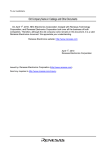
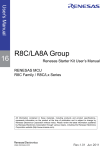

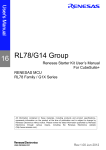
![[e 2 studio] Renesas Starter Kit for RL78/G14 User`s Manual](http://vs1.manualzilla.com/store/data/005759786_1-25eb95ad780cf22f415f84b4d3ed0c87-150x150.png)

